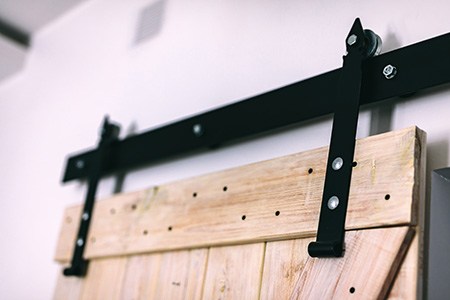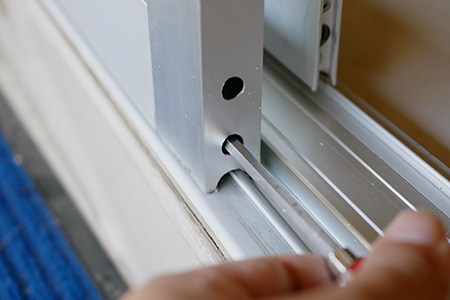How to Remove a Pocket Door From Its Track Easily
Author: Omar Alonso | Editor: Omar Alonso
Review & Research: Jen Worst & Chris Miller

Do you have a pocket door in your home? It's a common feature providing a compact entrance to a closet, bathroom, or area of the house where a swinging door won't work. This sounds great until you need to learn how to remove a pocket door and realize you don't know how.
A pocket door leaves more room around the doorway, fitting neatly into a "pocket" in the wall instead of swinging open like a conventional door.
The only issue with pocket doors is that, despite their convenience, they tend to require more maintenance to the rails, track, and rollers. Opening and closing the pocket door creates wear and tear on these components, which might be problematic for high-traffic rooms in the home.
Fortunately, this guide shows you how to remove and maintain your pocket door.
Tools For the Pocket Door Removal Job
You'll need the following tools for the task:
- Screwdriver
- Pliers
- Hammer
- Power drill
- Flat bar
You should also have an emergency kit nearby and be aware of where it is in case you injure yourself, but hopefully, that won't happen. Safety first!
How to Remove a Pocket Door Without Removing the Trim in 5 Steps

Removing the pocket door without destroying or removing the trim might seem challenging, but we assure you it's easier than it looks – all you need is the right strategy designed for these types of interior doors. We broke the task down into five easy steps. Follow them, and you'll successfully remove the pocket door without causing any damage.
Pocket doors are lightweight and easy to maneuver, but we recommend you have another set of hands available for the task. They'll help you with handling the door and prevent it from falling over, which is important, especially if you have mirror glass installed on the rear or nearby.
Our final tip before we start is to remember to be gentle with the components, like the rollers, as breaking or damaging them becomes a hassle to replace. With this in mind, let's get to work!
1) Find the Jamb Stopper
You'll find the jamb stoppers at the head of the track, positioned just above the pocket door. You can find them at the bottom track as well. These keep the pocket door centered between the jamb and prevent it from rubbing and/or rocking from side to side, keeping it over and under the tracks properly.
They can look like "J-shaped" hardware or tabs screwed into the jambs on either side, and you'll need to detach it with a screwdriver. Unscrew the fasteners and remove the jamb stopper.
If you have an assistant, ask them to hold the pocket door to take the weight off the hardware for easier removal and to prevent the bottom of the door from crashing into the floor when you detach the stopper.
2) Lift the Door Off the Tracks
We now need to discuss removing a pocket door from the track. This step works for those pocket doors featuring a J-track. If the pocket door features a trolley mechanism, it won't apply. Lift the weight of the door from the bottom and disengage the rollers from the sliding track.
If the door has a trolley mechanism, use your screwdriver to create more slack to allow easy removal. Swing the pocket door out gently towards you and push it up to disconnect the wheels from the J-track. You'll have to get the carriage door at just the right angle to remove the door, so have patience with the process and gently maneuver it into position.
If you have a heavy pocket door, ensure your assistant is nearby to help you cope with the weight when removing the door.
3) Remove the Rollers
Find the base of the roller and unscrew it from the door frame while keeping the roller in position. Remove the roller after taking care of the door frames. Remember where you put the metal brackets and screws so you can find them later when reassembling the door and mounting the new rollers.
4) Remove the Pocket Door

And now for the reason you're learning how to remove a pocket door. Don't let the rollers contact the track, as it prevents you from removing the door from the frame. Slide it into position and push the pocket door out of the sliding space. This process is easier if someone guides the pocket door to prevent it from jumping and pushing into the frame. And that's how to remove a pocket door without removing the molding.
5) Optional: Remove the Track
This is the hard part of the process, especially if you have to fully remove the pocket door or if you're changing the track. When removing your pocket door, it's critical to ensure the door track matches your hanging mechanism.
Many models aren't interchangeable, so you'll have to get an OEM (Original Equipment Manufacturer) spare from the manufacturer. Changing the whole track and adding a new door isn't worth the expense or your time.
Old tracks might lose function and become noisy or sticky over time, especially in high-traffic rooms. So, in this case, it makes sense to replace the track.
Use the following process if you experience this problem:
- Locate the internal track using a stud finder.
- Mark the location of the studs and internal hardware using a pencil.
- Cut a square opening around the frame using a drywall cutting saw.
- Create a hole large enough to accommodate a drill bit or your screwdriver.
- Remove the track screws.
- You'll find you have access to screws through the hole you made in the wall.
- Ensure you remove the screws in the top sides of the frame and track.
- After removing the screws, unscrew the hinges and slide the door track out.
You’ll essentially need to reverse the process if your intention is to reinstall a different track and a different pocket door. Unfortunately, cutting the drywall is a necessity and will cause more maintenance work to be completed in that regard.
If you won’t install another pocket door, you can consider cutting the track back to a point where it will be behind the new door frame and let it remain screwed to the ground within the wall. This will keep you from needing to cut the drywall. If this sounds like you, then check out our list of pocket door alternatives to explore.
5 Steps to Maintaining Your Pocket Door

So, now that you know how to remove the pocket door without damaging or removing the trim, it's time to maintain it and get it back in position. Follow these DIY steps to recondition the door, and you'll find it opens and closes smoothly without making any noise.
1) Lubricate the Track Rollers
If the pocket door is challenging to open or hard to lock, it probably means the rollers need lubricating. Avoid using oil or water-displacement lubricants for the task. These lubricants attract dirt and dust, seizing them fast.
Instead, give the rollers a blast with some silicone stray for the best results. Run the rollers back and forth to distribute the spray and loosen them.
2) Tighten the Track Rollers
The door might be loose if it's in a high-traffic room and used frequently. Tighten the accessible track, and don't loosen the trim. You don't need to know how to remove a pocket door to do this, either.
3) Replace Damaged Door Tracks

If you have to unhang the track and replace it, you'll need to remove a part of the drywall using the method we described earlier in step #5. After removing it and detaching the screws with your drill or screwdriver, remove the retention clips.
Reach into the section of the pocket door opening and loosen the track. Remove the track and replace it with a new one.
4) Realign Uneven Pocket Doors
If the pocket door is in position and slides well, but it fails to meet the end squarely when closed, you'll need to realign the door. Uneven or misaligned rollers cause this issue, resulting in the door protruding when opening it.
Use a flashlight to locate the adjustable rollers on top of the pocket door and turn the rollers with a specialized pocket door wrench. This action raises or lowers the door, bringing it back into the correct alignment. Make sure you adjust them carefully to prevent damage to the clip and hanger.
5) Level the Door Track
If the door doesn't slide well because it's uneven, it means the door track isn't level and needs adjustment. Realigning the rollers might help a little, but it probably won't solve the issue.
If the door track isn't running correctly on the level, you'll have to remove and reinstall or replace the level. After removing the door track, hold the level against the attachment point on the track. If this point isn't level, bolt up the shims.
Add the shims in place till the level reaches the right level and install a new track.
Tips for Optimal Pocket Door Performance

Regular maintenance of your pocket door gives it a longer service life, and you'll have fewer issues with the problems mentioned above. No homeowner wants to have to deal with a faulty pocket door, so keeping it in good condition makes sense if you want to reduce these maintenance issues.
Use these tips to keep your pocket door in tip-top condition year-round.
Use the Right Lubricant
We recommend using silicone lubricant on the rollers. It lasts longer than water or oil-based dispersion lubricants and doesn't attract as much debris or dust to the rollers. Spray the rollers every six months, and you'll find you never have issues with a sticky pocket door or creaking as you open and close it.
Clean the Rollers & Track Regularly
If you take the time to clean the rollers and track once a year, you'll find the pocket door assembly lasts much longer than if you leave it alone and never maintain it. Lubricate the rollers and ensure the pocket door assembly is aligned properly and level.
And That’s How to Remove a Pocket Door
Pocket doors are the ideal solution for homes and rooms with smaller living spaces. These doors operate like sliding doors, removing the need for floor space to open and close a conventional swinging door. You get more space in the room and easy entry and exit from the living space.
However, pocket doors are prone to misalignment, resulting in a sticky door or issues with locking it. Misaligned doors are the top cause of problems occurring with the track and rollers, resulting in a replacement of these components due to excessive wear and tear. And that starts with learning how to take off a pocket door.
While it's possible to fix it with a DIY job, call the professionals if you don't have the handy skills, the time, or patience to deal with the problem yourself. They’ll know how to remove a pocket door efficiently without causing any extra damage or problems.



